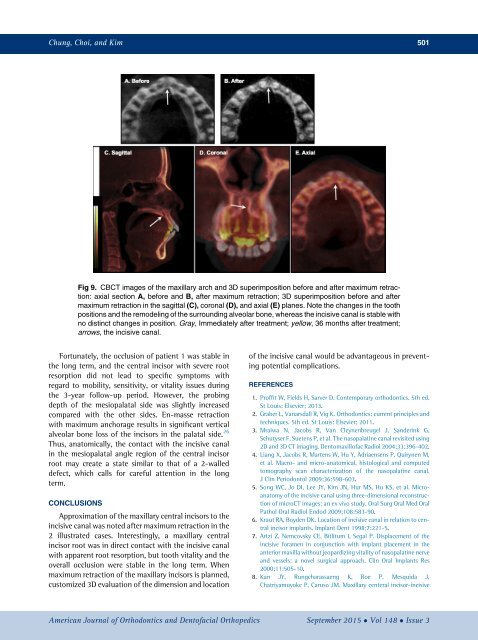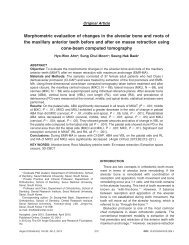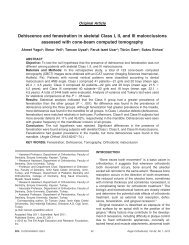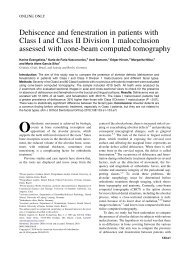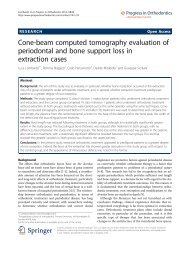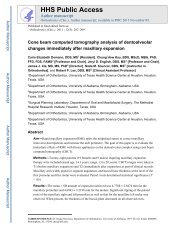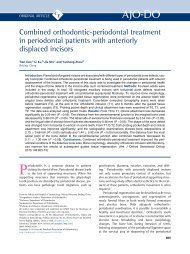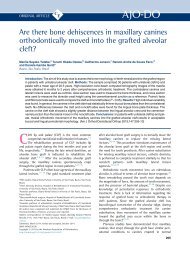Approximation and contact of the maxillary central incisor roots with the incisive canal after maximum retraction with temporary anchorage devices_ Report of 2 patients
artigos ortodontia
artigos ortodontia
Create successful ePaper yourself
Turn your PDF publications into a flip-book with our unique Google optimized e-Paper software.
Chung, Choi, <strong>and</strong> Kim 501<br />
Fig 9. CBCT images <strong>of</strong> <strong>the</strong> <strong>maxillary</strong> arch <strong>and</strong> 3D superimposition before <strong>and</strong> <strong>after</strong> <strong>maximum</strong> <strong>retraction</strong>:<br />
axial section A, before <strong>and</strong> B, <strong>after</strong> <strong>maximum</strong> <strong>retraction</strong>; 3D superimposition before <strong>and</strong> <strong>after</strong><br />
<strong>maximum</strong> <strong>retraction</strong> in <strong>the</strong> sagittal (C), coronal (D), <strong>and</strong> axial (E) planes. Note <strong>the</strong> changes in <strong>the</strong> tooth<br />
positions <strong>and</strong> <strong>the</strong> remodeling <strong>of</strong> <strong>the</strong> surrounding alveolar bone, whereas <strong>the</strong> <strong>incisive</strong> <strong>canal</strong> is stable <strong>with</strong><br />
no distinct changes in position. Gray, Immediately <strong>after</strong> treatment; yellow, 36 months <strong>after</strong> treatment;<br />
arrows, <strong>the</strong> <strong>incisive</strong> <strong>canal</strong>.<br />
Fortunately, <strong>the</strong> occlusion <strong>of</strong> patient 1 was stable in<br />
<strong>the</strong> long term, <strong>and</strong> <strong>the</strong> <strong>central</strong> <strong>incisor</strong> <strong>with</strong> severe root<br />
resorption did not lead to specific symptoms <strong>with</strong><br />
regard to mobility, sensitivity, or vitality issues during<br />
<strong>the</strong> 3-year follow-up period. However, <strong>the</strong> probing<br />
depth <strong>of</strong> <strong>the</strong> mesiopalatal side was slightly increased<br />
compared <strong>with</strong> <strong>the</strong> o<strong>the</strong>r sides. En-masse <strong>retraction</strong><br />
<strong>with</strong> <strong>maximum</strong> <strong>anchorage</strong> results in significant vertical<br />
alveolar bone loss <strong>of</strong> <strong>the</strong> <strong>incisor</strong>s in <strong>the</strong> palatal side. 26<br />
Thus, anatomically, <strong>the</strong> <strong>contact</strong> <strong>with</strong> <strong>the</strong> <strong>incisive</strong> <strong>canal</strong><br />
in <strong>the</strong> mesiopalatal angle region <strong>of</strong> <strong>the</strong> <strong>central</strong> <strong>incisor</strong><br />
root may create a state similar to that <strong>of</strong> a 2-walled<br />
defect, which calls for careful attention in <strong>the</strong> long<br />
term.<br />
CONCLUSIONS<br />
<strong>Approximation</strong> <strong>of</strong> <strong>the</strong> <strong>maxillary</strong> <strong>central</strong> <strong>incisor</strong>s to <strong>the</strong><br />
<strong>incisive</strong> <strong>canal</strong> was noted <strong>after</strong> <strong>maximum</strong> <strong>retraction</strong> in <strong>the</strong><br />
2 illustrated cases. Interestingly, a <strong>maxillary</strong> <strong>central</strong><br />
<strong>incisor</strong> root was in direct <strong>contact</strong> <strong>with</strong> <strong>the</strong> <strong>incisive</strong> <strong>canal</strong><br />
<strong>with</strong> apparent root resorption, but tooth vitality <strong>and</strong> <strong>the</strong><br />
overall occlusion were stable in <strong>the</strong> long term. When<br />
<strong>maximum</strong> <strong>retraction</strong> <strong>of</strong> <strong>the</strong> <strong>maxillary</strong> <strong>incisor</strong>s is planned,<br />
customized 3D evaluation <strong>of</strong> <strong>the</strong> dimension <strong>and</strong> location<br />
<strong>of</strong> <strong>the</strong> <strong>incisive</strong> <strong>canal</strong> would be advantageous in preventing<br />
potential complications.<br />
REFERENCES<br />
1. Pr<strong>of</strong>fit W, Fields H, Sarver D. Con<strong>temporary</strong> orthodontics. 5th ed.<br />
St Louis: Elsevier; 2013.<br />
2. Graber L, Vanarsdall R, Vig K. Orthodontics: current principles <strong>and</strong><br />
techniques. 5th ed. St Louis: Elsevier; 2011.<br />
3. Mraiwa N, Jacobs R, Van Cleynenbreugel J, S<strong>and</strong>erink G,<br />
Schutyser F, Suetens P, et al. The nasopalatine <strong>canal</strong> revisited using<br />
2D <strong>and</strong> 3D CT imaging. Dentomaxill<strong>of</strong>ac Radiol 2004;33:396-402.<br />
4. Liang X, Jacobs R, Martens W, Hu Y, Adriaensens P, Quirynen M,<br />
et al. Macro- <strong>and</strong> micro-anatomical, histological <strong>and</strong> computed<br />
tomography scan characterization <strong>of</strong> <strong>the</strong> nasopalatine <strong>canal</strong>.<br />
J Clin Periodontol 2009;36:598-603.<br />
5. Song WC, Jo DI, Lee JY, Kim JN, Hur MS, Hu KS, et al. Microanatomy<br />
<strong>of</strong> <strong>the</strong> <strong>incisive</strong> <strong>canal</strong> using three-dimensional reconstruction<br />
<strong>of</strong> microCT images: an ex vivo study. Oral Surg Oral Med Oral<br />
Pathol Oral Radiol Endod 2009;108:583-90.<br />
6. Kraut RA, Boyden DK. Location <strong>of</strong> <strong>incisive</strong> <strong>canal</strong> in relation to <strong>central</strong><br />
<strong>incisor</strong> implants. Implant Dent 1998;7:221-5.<br />
7. Artzi Z, Nemcovsky CE, Bitlitum I, Segal P. Displacement <strong>of</strong> <strong>the</strong><br />
<strong>incisive</strong> foramen in conjunction <strong>with</strong> implant placement in <strong>the</strong><br />
anterior maxilla <strong>with</strong>out jeopardizing vitality <strong>of</strong> nasopalatine nerve<br />
<strong>and</strong> vessels: a novel surgical approach. Clin Oral Implants Res<br />
2000;11:505-10.<br />
8. Kan JY, Rungcharassaeng K, Roe P, Mesquida J,<br />
Chatriyamuyoke P, Caruso JM. Maxillary centeral <strong>incisor</strong>-<strong>incisive</strong><br />
American Journal <strong>of</strong> Orthodontics <strong>and</strong> Dent<strong>of</strong>acial Orthopedics September 2015 Vol 148 Issue 3


